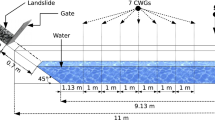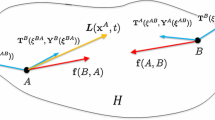Abstract
Marine gas hydrate is an important energy source while its extraction may induce environmental problems such as subsea landslide, which is usually challengeable for numerical simulation due to the marine environment with high pressure and the existence of gas hydrate. Smoothed particle hydrodynamics (SPH) is a Lagrangian particle method which is attractive in modeling problems with large deformations and fluid–solid interactions (FSI) for continuum and granular materials. However, the conventional SPH suffers from numerical instability when modeling the soil mechanics with the high confining stress. A mixed SPH is developed in this study to simulate hydrate-bearing sediment with the characteristics of high confining stress. In the mixed SPH model, the conventional SPH is used to discretize the momentum equations, and the kernel gradient correction (KGC) SPH is used to discretize strain and spin rate tensors. In order to consider the effect of hydrate saturation on the strength of soil-hydrate material, an existing linear model is applied into the mixed SPH to define the mechanic parameters of soil-hydrate material. The mixed SPH method is validated by several examples and the obtained numerical results are in close agreement with experimental observations. Finally, the mixed SPH method is used to model landslide of hydrate bearing sediments. The results show that the saturation of hydrate has important impact on the stability of hydrate bearing sediments.

















Similar content being viewed by others
References
Sultan N, Cochonat P, Foucher JP, Mienert J (2004) Effect of gas hydrates melting on seafloor slope instability. Mar Geol 213:379–401
Waite WF, Santamarina JC, Cortes DD, Dugan B, Espinoza DN, Germaine J, Jang J, Jung JW, Kneafsey TJ, Shin H, Soga K, Winters WJ, Yun T-S (2009) Physical properties of hydrate-bearing sediments. Rev Geophys 47:RG4003
Li Y, Liu W, Zhu Y, Chen Y, Song Y, Li Q (2016) Mechanical behaviors of permafrost-associated methane hydrate-bearing sediments under different mining methods. Appl Energy 162:1627–1632
Xu W, Germanovich LN (2006) Excess pore pressure resulting from methane hydrate dissociation in marine sediments: a theoretical approach. J Geophys Res Solid Earth. https://doi.org/10.1029/2004JB003600
Yun TS, Santamarina JC, Ruppel C (2007) Mechanical properties of sand, silt, and clay containing tetrahydrofuran hydrate. J Geophys Res Solid Earth. https://doi.org/10.1029/2006JB004484
Hyodo M, Li Y, Yoneda J, Nakata Y, Yoshimoto N, Nishimura A (2014) Effects of dissociation on the shear strength and deformation behavior of methane hydrate-bearing sediments. Mar Pet Geol 51:52–62
Zhang XH, Lu XB, Chen XD, Zhang LM, Shi YH (2016) Mechanism of soil stratum instability induced by hydrate dissociation. Ocean Eng 122:74–83
Ye T, Pan D, Huang C, Liu M (2019) Smoothed particle hydrodynamics (SPH) for complex fluid flows: recent developments in methodology and applications. Phys Fluids 31:011301
Liu M, Zhang Z (2019) Smoothed particle hydrodynamics (SPH) for modeling fluid-structure interactions. Sci China Phys Mech Astron 62:984701
Bui HH, Fukagawa R, Sako K, Ohno S (2008) Lagrangian meshfree particles method (SPH) for large deformation and failure flows of geomaterial using elastic–plastic soil constitutive model. Int J Numer Anal Meth Geomech 32:1537–1570
Huang Y, Zhang W, Dai Z, Xu Q (2013) Numerical simulation of flow processes in liquefied soils using a soil–water-coupled smoothed particle hydrodynamics method. Nat Hazards 69:809–827
Chen D, Huang W, Sloan SW (2019) An alternative updated Lagrangian formulation for finite particle method. Comput Methods Appl Mech Eng 343:490–505
Chen D, Huang W, Lyamin A (2020) Finite particle method for static deformation problems solved using JFNK method. Comput Geotech 122:103502
Wang Y, Bui HH, Nguyen GD, Ranjith PG (2019) A new SPH-based continuum framework with an embedded fracture process zone for modelling rock fracture. Int J Solids Struct 159:40–57
Wang Y, Tran HT, Nguyen GD, Ranjith PG, Bui HH (2020) Simulation of mixed-mode fracture using SPH particles with an embedded fracture process zone. Int J Numer Anal Methods Geomech 44(10):1417–1445
Yang E, Bui HH, De Sterck H, Nguyen GD, Bouazza A (2020) A scalable parallel computing SPH framework for predictions of geophysical granular flows. Comput Geotech 121:103474
Zhao S, Bui HH, Lemiale V, Nguyen GD, Darve F (2019) A generic approach to modelling flexible confined boundary conditions in SPH and its application. Int J Numer Anal Meth Geomech 43:1005–1031
Huang C, Zhang DH, Shi YX, Si YL, Huang B (2018) Coupled finite particle method with a modified particle shifting technology. Int J Numer Meth Eng 113:179–207
Huang C, Zhang DH, Si YL, Shi YX, Lin YG (2018) Coupled finite particle method for simulations of wave and structure interaction. Coast Eng 140:147–160
Miyazaki K, Masui A, Sakamoto Y, Aoki K, Tenma N, Yamaguchi T (2011) Triaxial compressive properties of artificial methane-hydrate-bearing sediment. J Geophys Res Solid Earth 116:102
Soga K, Lee SL, Ng MYA, Klar A (2006) Characterisation and engineering properties of methane hydrate soils. In: Tan TS, Phoon KK, Hight DW, Lerouil S (eds) 2nd International Workshop on Characterisation and Engineering Properties of Natural Soils. CRC Press, Boca Raton, pp 2591–2642
Uchida S, Soga K, Yamamoto K (2012) Critical state soil constitutive model for methane hydrate soil. J Geophys Res Solid Earth 117:209
Monaghan JJ (2005) Smoothed particle hydrodynamics. Rep Prog Phys 68:1703–1759
Liu MB, Liu GR (2010) Smoothed Particle Hydrodynamics (SPH): an overview and recent developments. Arch Comput Methods Eng 17:25–76
Liu GR, Liu MB (2003) Smoothed particle hydrodynamics: a meshfree particle method. World Scientific Publishing Co Pte. Ltd., Singapore
Liu MB, Xie WP, Liu GR (2005) Modeling incompressible flows using a finite particle method. Appl Math Model 29:1252–1270
Liu MB, Liu GR (2006) Restoring particle consistency in smoothed particle hydrodynamics. Appl Numer Math 56:19–36
Bonet J, Lok T-SL (1999) Variational and momentum preservation aspects of Smooth Particle Hydrodynamic formulations. Comput Methods Appl Mech Eng 180:97–115
Jiang T, Chen ZC, Lu WG, Yuan JY, Wang DS (2018) An efficient split-step and implicit pure mesh-free method for the 2D/3D nonlinear Gross–Pitaevskii equations. Comput Phys Commun
Ren J, Jiang T, Lu W, Li G (2016) An improved parallel SPH approach to solve 3D transient generalized Newtonian free surface flows. Comput Phys Commun 205:87–105
Zhang ZL, Ma T, Liu MB, Feng D (2019) Numerical study on high velocity impact welding using a modified SPH method. Int J Comput Methods 16:1846001
Zhang ZL, Liu MB (2019) Numerical studies on explosive welding with ANFO by using a density adaptive SPH method. J Manufact Process 41:208–220
Colagrossi A, Antuono M, Le Touze D (2009) Theoretical considerations on the free-surface role in the smoothed-particle-hydrodynamics model. Phys Rev E 79:056701
Bui HH, Fukagawa R (2013) An improved SPH method for saturated soils and its application to investigate the mechanisms of embankment failure: case of hydrostatic pore-water pressure. Int J Numer Anal Meth Geomech 37:31–50
Xu R, Stansby P, Laurence D (2009) Accuracy and stability in incompressible SPH (ISPH) based on the projection method and a new approach. J Comput Phys 228:6703–6725
Sun P, Zhang AM, Marrone S, Ming F (2018) An accurate and efficient SPH modeling of the water entry of circular cylinders. Appl Ocean Res 72:60–75
He F, Zhang H, Huang C, Liu M (2020) Numerical investigation of the solitary wave breaking over a slope by using the finite particle method. Coastal Eng 156:103617
Jiang T, Ren J, Yuan J, Zhou W, Wang D-S (2020) A least-squares particle model with other techniques for 2D viscoelastic fluid/free surface flow. J Comput Phys 407:109255
Kiriyama T (2013) Numerical simulations of progressive failure of triaxial compression tests using generalized interpolation material point method. J Jpn Soc Civil Eng Ser A2 (Appl Mech (AM)) 69:I_321–I_332
Masui A, Haneda H, Ogata Y, Aoki K (2006) Triaxial test on submarine sediment containing methane hydrate in deap sea off the coast off Japan. In: 41st Annual Conference, Jpn. Geotech. Soc., Kagoshima, Japan
Huang C, Long T, Li SM, Liu MB (2019) A kernel gradient-free SPH method with iterative particle shifting technology for modeling low-Reynolds flows around airfoils. Eng Anal Boundary Elem 106:571–587
Huang C, Long T, Liu MB (2019) Coupling finite difference method with finite particle method for modeling viscous incompressible flows. Int J Numer Meth Fluids 90:564–583
Bui HH, Sako K, Fukagawa R (2007) Numerical simulation of soil–water interaction using smoothed particle hydrodynamics (SPH) method. J Terrramech 44:339–346
Nguyen CT, Nguyen CT, Bui HH, Nguyen GD, Fukagawa R (2017) A new SPH-based approach to simulation of granular flows using viscous damping and stress regularisation. Landslides 14:69–81
Acknowledgements
The work has been financially supported by the Joint Program of Beijing Municipal Foundation and Education Commission (Grant No. KZ202010009015), the National Science Foundation of China (NSFC) (Grant No. 51779003), the National Natural Science Foundation of China (Grant No. 11702294), Beijing Natural Science Foundation (Grant No. 4204097), the Research and Development Program of Handan Science and Technology (Grant No. 19422121008-25) and the China Postdoctoral Science Foundation (CPSF) (Grant No. 2019M660310). Great appreciation is also given to Dr. Ding Chen, Dr. Shaohan Zhao and Dr. Yingnan Wang who provided helpful suggestions for this work. The authors are also grateful to the referees while the constructive suggestions greatly improved the paper.
Author information
Authors and Affiliations
Corresponding author
Additional information
Publisher's Note
Springer Nature remains neutral with regard to jurisdictional claims in published maps and institutional affiliations.
Rights and permissions
About this article
Cite this article
Huang, C., Liu, M.B. Modeling hydrate-bearing sediment with a mixed smoothed particle hydrodynamics. Comput Mech 66, 877–891 (2020). https://doi.org/10.1007/s00466-020-01895-1
Received:
Accepted:
Published:
Issue Date:
DOI: https://doi.org/10.1007/s00466-020-01895-1




